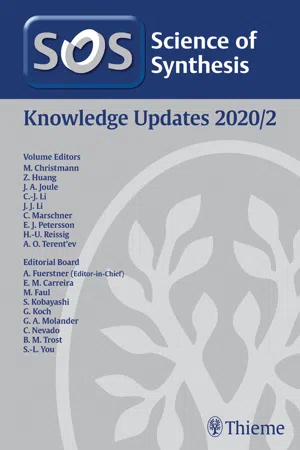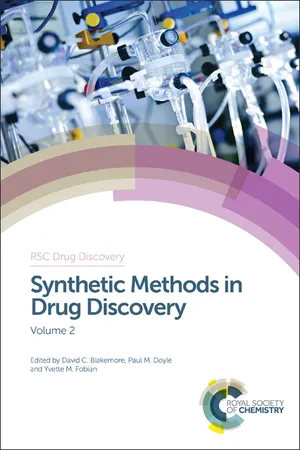Chemistry
Amide Reactions
Amide reactions involve the chemical transformation of amides, which are compounds containing a carbonyl group bonded to an amine group. These reactions can include hydrolysis, reduction, and substitution, and are important in organic synthesis for creating a wide range of compounds. Amide reactions are widely studied and utilized in pharmaceutical, agricultural, and materials chemistry.
Written by Perlego with AI-assistance
Related key terms
1 of 5
3 Key excerpts on "Amide Reactions"
- M. Christmann, Z. Huang, J. A. Joule, M. Christmann, Z. Huang, J. A. Joule(Authors)
- 2020(Publication Date)
- Thieme(Publisher)
315 40.1. 1.4.3 Synthesis of Amines by Rearrangement (Update 2020) C. I. Ochoa and U. K. Tambar General Introduction The synthesis of amines is one of the most important areas of research in organic chemis-try due to the prevalence of nitrogen atoms in many functional molecules, including nat-ural products, pharmaceutical drugs, and agrochemicals. The synthesis of amines through rearrangement reactions has been heavily researched and discussed over the past few decades. One of the most comprehensive reviews of this topic was included in Science of Synthesis (Section 40.1.1.4). The chapter was arranged in two sections: rearrange-ments from carbon to nitrogen, and rearrangements from nitrogen to carbon. In this ex-tension of the original chapter, the same organization is preserved for consistency and ease of cross-referencing between the two chapters. The purpose of this chapter is to pro-vide an up-to-date account of new methods and synthetic developments in amine re-arrangement reactions within the last decade. Over this period of time, new chemistry has been developed which was not discussed in any particular section in the original ac-count on this topic. Thus, this chapter will not only serve as a supplementary document to the previous volume. It will also be a source of new synthetic strategies not discussed previously. It should be noted that although this section of Science of Synthesis is focused on the formation of alkyl-and cycloalkylamines, some examples shown in this chapter give products that are not part of these two categories; examples that give products such as anilines, amides, and ureas, have also been included to highlight both the broad scope and the power of the rearrangement reactions discussed. Every effort has been made to make this an in-depth review; however, there may be publications that have been inten-tionally or unintentionally omitted. 40.1. 1.4.3.1 Rearrangements from Nitrogen to Carbon 40.1.- eBook - PDF
- David C Blakemore, Paul M Doyle, Yvette M Fobian(Authors)
- 2016(Publication Date)
- Royal Society of Chemistry(Publisher)
CHAPTER 17 Catalytic Amide Bond Forming Methods BENJAMIN N. ATKINSON, A. ROSIE CHHATWAL AND JONATHAN M. J. WILLIAMS* Department of Chemistry, University of Bath, Claverton Down, Bath BA2 7AY, UK *Email: [email protected] 17.1 Amidation of Carboxylic Acids The formation of amide bonds from carboxylic acids and amines is a widely investigated and documented process. 1,2 It is synthetically the most direct route to forming amide bonds with the sole by-product being water and is therefore of great interest. This transformation often requires the use of coupling agents to activate the carboxylic acid to nucleophilic attack. A wide range of coupling agents are typically employed in the pharmaceutical industry and the most commonly used and effective include CDI, HBTU, HATU, COMU, TBTU and T 3 P. While this method has its advantages within industrial processes, there have been significant developments generating more atom efficient, cheaper and cleaner methods of performing this reaction and this chapter will focus on these. While these methods are still developing, a key desire in industry is a highly effective catalytic amide coupling reaction and this chapter will examine the current state of the art. Several metal and non-metal catalysts have shown potential in catalysing this transformation. These catalysts aim to address some of the issues associated with the coupling agents that are currently used; however, their use does lead to some alternative issues. RSC Drug Discovery Series No. 53 Synthetic Methods in Drug Discovery: Volume 2 Edited by David Blakemore, Paul Doyle and Yvette Fobian r The Royal Society of Chemistry 2016 Published by the Royal Society of Chemistry, www.rsc.org 413 - eBook - PDF
- Stanley R. Sandler, Wolf Karo, Alfred T. Blomquist, Harry Wasserman(Authors)
- 2013(Publication Date)
- Academic Press(Publisher)
CHAPTER 6 / AMIDINES 1. Introduction 205 2. Condensation Reactions . . . . . . . . . . 207 A. Reaction of Nitriles with Ammonia, Amines, and Their Derivatives . . 207 2-1. Preparation of p-Methylsulfonylbenzamidinium Benzenesulfonate . 2 1 0 2-2. Preparation of p-Chlorobenzamidine Thiocyanate . . . . 2 1 0 2-3. Preparation of N-Phenyl-N-methylbenzamidine . 2 1 1 2-4. Preparation of Benzamidine Hydrochloride . 2 1 4 2-5. General Procedure for the Reaction of Halogenomagnesium Dialkylamides with Nitriles to Prepare N^N-Disubstituted Amidines . 2 1 6 3. Substitution Reactions 217 A. Reaction of Imidates Derived from Nitriles with Ammonia, Amines, and Their Derivatives 217 3-1. Preparation of N-Cyanoacetamidine (Method J) . . . . . 2 2 1 3-2. Preparation of N-Cyanoacetamidine (Method 2) . . . . . . 221 3-3. Preparation of 3-Amidinopyridine . . 2 2 1 B. Reaction of Amines with Ortho Esters 222 3-4. Preparation of Ή,Ή'-Dicyclohexylformamidine Acetate . . . . . 225 3-5. Preparation of Ν,Ν'-Diphenylacetamidine . . . . . . . 227 C. Reaction of Amide Derivatives with Amino Compounds to Give Amidines 227 3-6. Preparation ofΉ,Ν'-Diphenylbenzamidine . . . . . . . 228 3-7. Preparation ofN,N-Dimethyl-N'-phenylacetamidine . . . . . 229 3-8. General Procedure for the Preparation of Amidines by the Reaction of Amines with Imidate Tetrafluoroborates . . . . 233 4. Miscellaneous Methods 234 References 237 1. INTRODUCTION Amidines having the following structure (I) are described in this chapter: NR 1 II ^ R > R—C—N^ ^ R 3 (I) 205 206 6. Amidines where R, R 1 , R 2 , and R 3 , are H, alkyl, aryl, or heterocyclic groups. Amidines where the two nitrogen atoms are part of a heterocyclic ring system are not described in this chapter. The unsubstituted amidines are basic and react with acids to form crystalline hydrochlorides, sulfates, sulfonates, acetates, nitrates, carbonates, etc.
Index pages curate the most relevant extracts from our library of academic textbooks. They’ve been created using an in-house natural language model (NLM), each adding context and meaning to key research topics.


